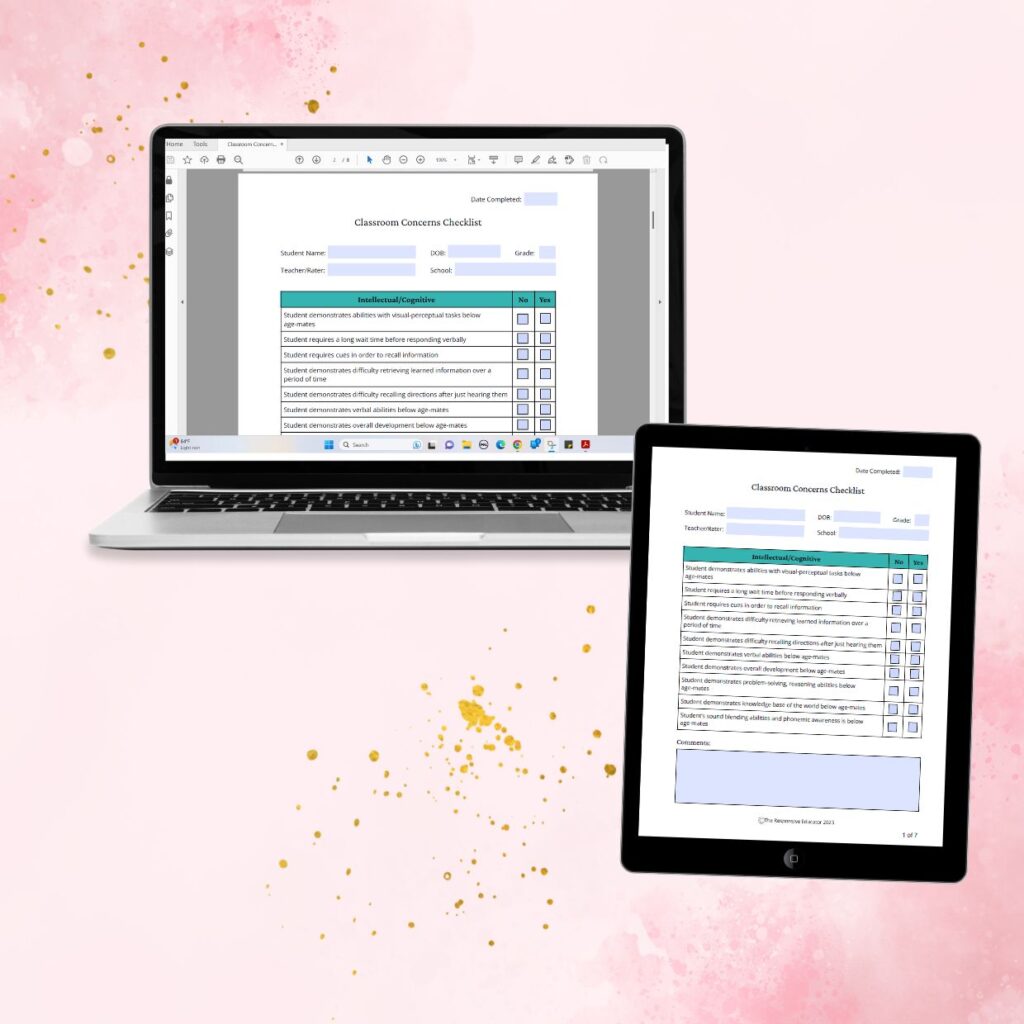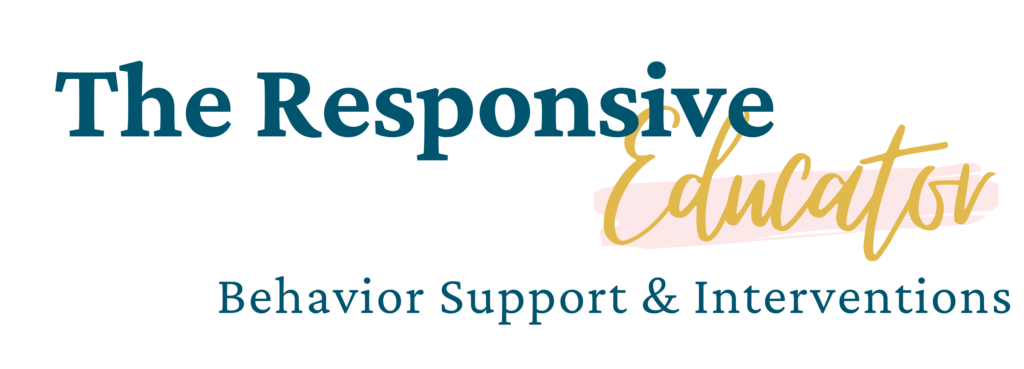
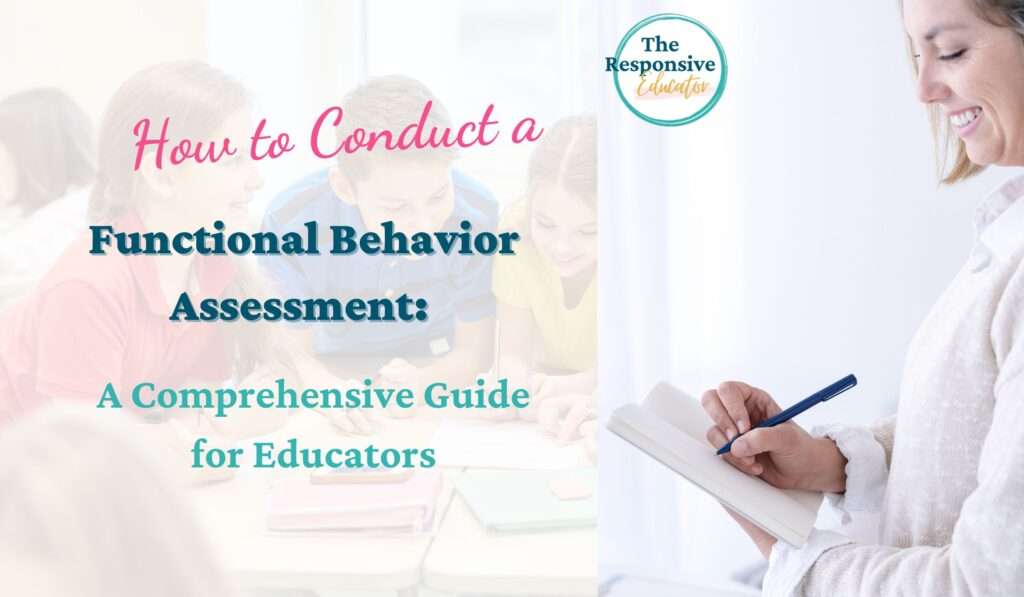
Functional Behaviour Assessments (FBAs) play a vital role in the educational setting, aiming to identify the underlying reasons for a student’s challenging behaviors and creating personalized intervention plans to meet their unique needs. It is a crucial step towards establishing a supportive and positive learning environment for all students.
However, it is essential to acknowledge that many educators tasked with writing functional behaviour assessments may not have received sufficient training and support in this process. Whether it’s due to a lack of comprehensive training provided by their schools or inadequate preparation during their college education, some professionals might feel uncertain and less confident about conducting effective FBAs.
In recognition of this challenge, we understand the importance of bridging the knowledge gap and building educators’ confidence in conducting FBAs. Consider this blog post as your functional behaviour assessment training, designed to equip you with the essential tools and insights needed to confidently conduct high-quality FBAs that make a difference in your students’ lives.

Today, we will delve into the key components of an effective FBA, providing detailed explanations and offering practical examples to help you understand the process better.
If you find yourself in possession of a blank copy of the functional behavior assessment form that your district uses, having it available for reference while reading through each section may be helpful. And if you don’t have access to such a form, don’t worry, we’ve got you covered – here is a blank copy that you can use for reference throughout our exploration of FBAs. Let’s embark on this journey together to enhance your skills and create more impactful intervention plans for your students.
Note: I am an Amazon Affiliate. If you purchase products through the links provided, I will earn a small commission at no extra cost to you, which helps support the blog.
The Student Information section is usually located at the top of the first page and includes the student’s name, grade, school, and teacher (if applicable). Additionally, the report’s date and the name(s) of the individual(s) responsible for developing the FBA are typically included. If the current FBA is not the first one, it is essential to include the dates of all previous assessments. Although the specific information provided may vary slightly depending on the form, this section serves as a critical foundation for the rest of the assessment report.
The Student Information Section might look something like this:

While the overview section may not always be included in an FBA form, it can provide valuable information for future reference. The section should provide a brief description of the student and their behavior, as well as the reasons why the FBA is being written or updated. To gather this information, questions such as “Why is an FBA being written?” “When did the problem behavior first appear?” and “What is the history and course of the behavior over the past days/weeks/months/years?” can be asked.
The Overview/Reasons for FBA section might look something like this:

To ensure a thorough and comprehensive Functional Behaviour Assessment (FBA), data must be collected from multiple sources. Here is an illustrative example of how this can be done, along with a list of sources and explanations highlighting the information that can aid in developing a high-quality FBA.
For information on how to collect and use behavioral baseline data, see this blog post. And if you would like an overview of the most common types of behavior data collection used in schools, take a look at my FREE resource, Data Collection for Behavior.
The Sources of Data section of a Functional Behaviour Assessment might look something like this:
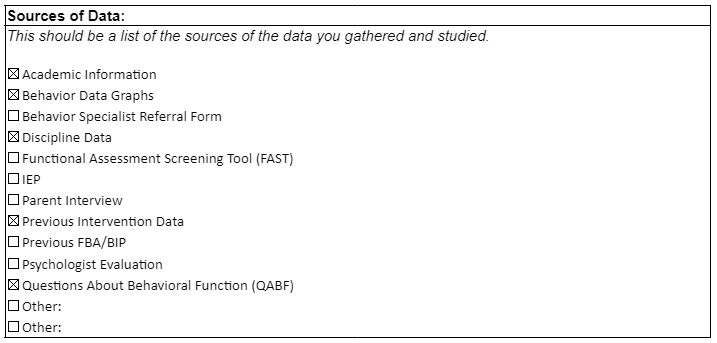
Academic performance data can be an important source of information for understanding the relationship between a student’s behavior and their academic success. By analyzing academic performance data, educators can identify patterns and trends in the student’s performance that may be related to their behavior.

For example, if a student consistently performs poorly on tests or assignments that require sustained attention and focus, it may suggest that they are struggling with attention or self-regulation skills. On the other hand, if a student performs well on tasks that are more engaging or interesting to them, it may suggest that they require more stimulating or challenging tasks to stay motivated and engaged.
Grades, standardized test scores, and teacher-made test results are all examples of academic performance data. Grades can provide an overall picture of a student’s performance in a particular subject or class. Standardized test scores can provide a measure of a student’s academic achievement in comparison to other students of the same age or grade level. Teacher-made test results can provide insights into a student’s understanding of specific concepts or skills and their ability to apply them.
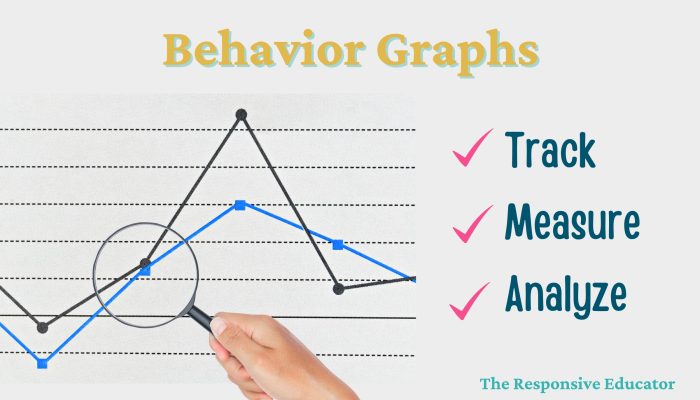
When considering a student’s behavior, it is important to have a clear understanding of what behaviors are occurring and how often they are happening.
One effective way to gain insight into behavior patterns is by using scatterplots or other visual aids that show the frequency, duration, or other relevant measures of behavior. This can provide a clear picture of the behaviors that are occurring at school, and can help identify any trends or patterns.
Additionally, utilizing graphs derived from the data collected during the Response to Intervention (RTI) process can be instrumental in establishing a baseline for a student’s behavior. RTI is a systematic approach that entails gathering data on a student’s academic and behavioral development over a period of time.
By incorporating data from the RTI process, educators can establish a foundation for the student’s behavior, facilitating the assessment of the efficacy of implemented interventions or behavior plans.

For example, a scatterplot might show that a student consistently engages in disruptive behavior during math class, but not during other classes. This information can be used to target interventions specifically to math class, rather than implementing a school-wide plan that may not be as effective.
Similarly, a graph of data collected during the RTI process might show that a student’s disruptive behavior has decreased over time as a result of an intervention. This data can be used to adjust the intervention as needed or to determine if further modifications are necessary.
Behavior screening tools are instruments designed to gather information on a student’s behavior patterns and provide insight into possible functions or reasons for that behavior. These tools can be used by educators and other professionals to better understand the needs of individual students and to inform the development of targeted interventions.
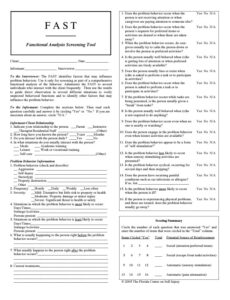
The Functional Assessment Screening Tool (FAST) is one example of a behavior screening tool. The FAST is a brief assessment that can be completed by teachers or other school personnel to identify potential functions of problem behavior, such as attention-seeking, escape, or sensory stimulation. The tool consists of a series of questions and rating scales designed to gather information on the frequency and severity of specific behaviors, as well as any contextual factors that may be contributing to the behavior.
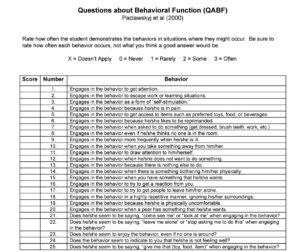
Another behavior screening tool is the Questions About Behavior Function (QABF), which is a standardized assessment designed to identify the function of problem behavior in individuals with intellectual or developmental disabilities. The QABF includes a series of questions that probe the antecedents and consequences of specific behaviors, as well as the individual’s communication and social skills.
While these tools are helpful for identifying potential functions of behavior, it’s important not to rely on them alone. Instead, take a holistic approach by considering multiple data sources to fully understand a student’s behavior. This might include direct observation, interviews with parents and caregivers, and information from the student’s educational records.
By using various data points, you are able to get a more accurate and complete picture of the student’s behavior. The goal is to use this diverse information to create a well-rounded behavior intervention plan that addresses the student’s specific needs and promotes positive behavior change. Emphasizing a comprehensive approach will lead to more effective interventions and better outcomes for the student.
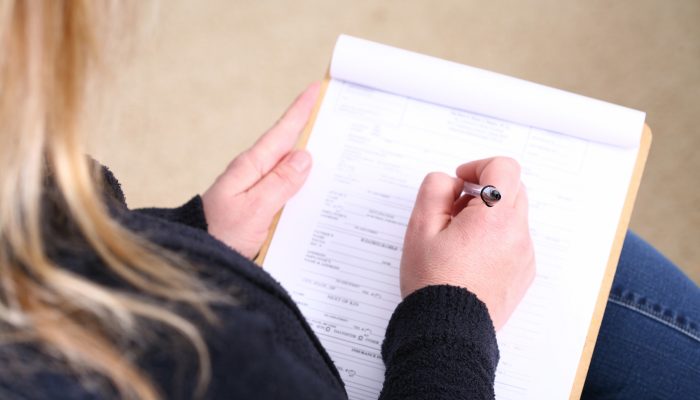
A Behavior Support Request Form (or a similar variant) is a document found in numerous school districts. Teachers utilize this form to formally seek assistance for a student grappling with challenging behaviors. Typically, the form is submitted to a designated team, such as the Teacher Assistance Team, Multi-Disciplinary Team (MDT), Multi-Tiered Systems of Support (MTSS) team, or a specialist/interventionist within the school district.
These request forms can provide valuable information about the student’s behavior, as well as insights into the specific situations or triggers that may be contributing to the behavior. For example, a teacher may report that a student has difficulty staying on task during independent work time and becomes disruptive when asked to complete assignments. This information can be used to identify potential antecedents and triggers for the behavior, as well as to develop strategies for addressing the behavior.
Additionally, a Behavior Support Request Form may include information about any interventions that have already been attempted and their effectiveness. This can help to identify which interventions may be appropriate to continue or modify, as well as to suggest new strategies for addressing the behavior.

Reviewing classroom discipline data and office discipline referrals can provide valuable information for completing a functional behavior assessment. When analyzing discipline data, it is important to look for patterns and trends in the behavior, such as whether the behavior occurs more frequently during certain times of day or in certain settings.
Be aware that sometimes there are multiple behaviors found within one write-up. Teachers may be forced to choose one behavior to “code” the incident, so read any anecdotal evidence that may be available to ensure that you are seeing all of the behaviors that took place within each incident.

For example, if a student is frequently sent to the office for disrupting class, reviewing the discipline data can help identify patterns in the behavior, such as whether it occurs during certain subjects or times of day.
Reading the anecdotal evidence from teachers can help identify the specific behaviors that the student is exhibiting, such as talking out of turn, leaving their seat without permission, or arguing with the teacher. All of this information can be used to develop a more accurate picture of the student’s behavior and to guide the development of a behavior intervention plan.

When reviewing the student’s IEP, it is important to pay attention to any past behavior-related information that may be included. This information can provide a helpful starting point for a functional behavior assessment.
Look for information on any past behavior difficulties in class, including any specific behaviors that were targeted in previous interventions. In addition, review the present levels of performance section of the IEP to identify any academic or behavioral areas in which the student is struggling. This can help to identify potential triggers for the student’s behavior.
Goals included in the IEP can also be a valuable source of information. Look for any behavior-related goals or objectives, as well as any academic goals that may be impacted by the student’s behavior.
Finally, conference or meeting notes can be useful for understanding the student’s behavior and any interventions that have been attempted in the past. Be sure to read through the notes carefully to identify any trends or patterns in the student’s behavior that may inform the functional behavior assessment.

Interview parents to get any information that may be helpful in understanding the student’s behavior. Information such as medical diagnosis or current medications might be useful, as well as the extent to which this behavior is seen at home, how it is addressed, and to see if there is any information that we may be able to use at school to help meet student needs.
Be aware that some parents will self-diagnose their child without a medical diagnosis to back it up. If you include diagnosis information, but have not seen a medical report, it is best to say something like “Parent reports that the student has a diagnosis of ______” rather than stating that the student has a particular diagnosis.

During the teacher interview, it’s important to discuss the behavior management system in place for the entire class and what has been done for the student in particular. As mentioned earlier, an FBA that leads to a BIP is a tier 3 intervention, which means that tiers 1 and 2 should have been addressed in the classroom before getting to this point. Therefore, it’s essential to review documentation and data that supports this claim.
It’s also helpful to look for patterns in the student’s behavior, such as whether the behavior occurs with certain teachers, during certain subjects, at certain times of day, etc. Identifying patterns can help in developing an effective intervention plan.

The student interview is a crucial step in the functional behavior assessment process. Through this interview, you can gain insights into how the student perceives themselves and their academic performance. Asking about their favorite and least favorite subjects can help determine whether problem behavior is due to an inability or unwillingness to complete tasks.
Additionally, it’s important to ask about the student’s interests, preferred leisure activities, and their favorite school staff members. This information can be invaluable in identifying potential sources of support and reinforcement.
If you need assistance with FBA interviews, my comprehensive set of interview forms is designed to help educators conduct functional behavior assessments. With Interview Questions- Behavior, you’ll have access to three different interview forms – one for parents, one for teachers, and one for students – each covering a range of important topics to help you gain a comprehensive understanding of the student’s behavior and needs.
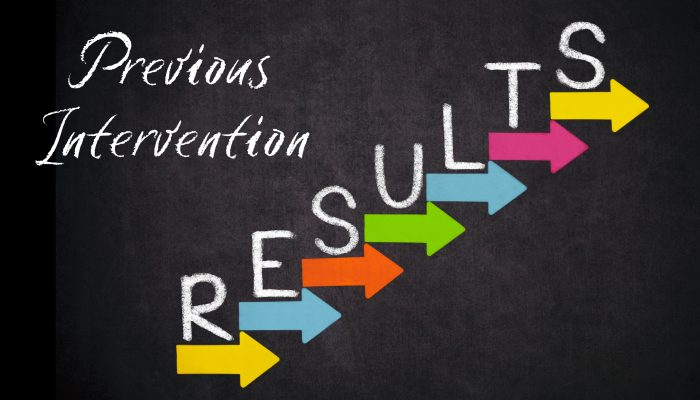
Using previous intervention data in a functional behaviour assessment is crucial. It helps identify academic and behavioral interventions used in the past and any available data. This review reveals successful strategies that can be included in the current behavior intervention plan.
Additionally, it’s important to check if any past successful interventions are still applicable. Some effective interventions may have been discontinued but could be worth trying again. Gathering data on successful interventions, reasons for their success, and why they were stopped will guide the development of new and more effective interventions.

Carefully consider past interventions and determine if they were effective and could be modified or reinstated to address current behavior concerns. For instance, if a previous FBA indicated that a student’s disruptive behavior was triggered by loud noises and a noise-canceling strategy was effective, you might avoid using loud noises in the classroom or provide noise-canceling headphones.
Similarly, if a past BIP included a reward system for positive behavior that worked well, consider incorporating a similar system in the new plan.
However, remember that target behaviors can change over time. A behavior that was once problematic may no longer be an issue, or a new behavior may have emerged. Additionally, successful interventions might eliminate the target behavior, but underlying issues may still need to be addressed. Continuing to monitor and adapt interventions ensures ongoing support and effectiveness.

When conducting a functional behaviour assessment, information from a psychologist’s evaluation can be invaluable. These evaluations can be conducted by school psychologists or by private clinical psychologists and may contain a wealth of information, such as medical conditions, personal history, academic or ability strengths and weaknesses, and more. By examining the results of the evaluation, you can identify any factors that may be impacting the student’s behavior.
For example, if the evaluation shows that a student has a low working memory score or slower processing speed, this could explain why the student struggles with attention and focus in the classroom. Additionally, if the evaluation reveals a history of trauma or mental health concerns, this could provide important context for the student’s behavior.

When reviewing psychologist reports, it’s important to look for information that could explain the behaviors being observed in the classroom. It’s important to note that understanding the results of a psychologist’s evaluation can be challenging, especially if you are not familiar with the terminology or testing procedures.
If you have questions or concerns about the results, it’s a good idea to reach out to someone knowledgeable for help in interpreting the report.
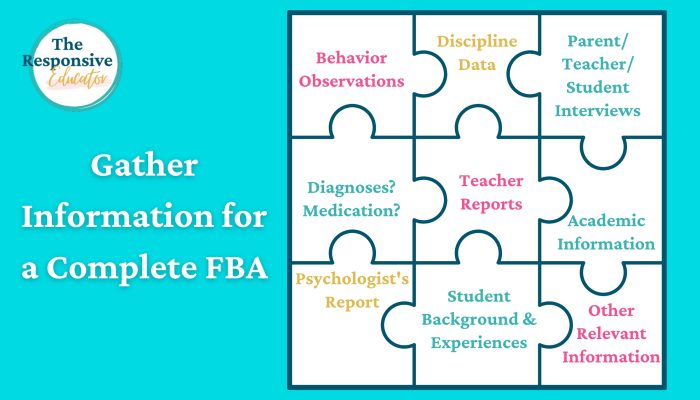
In addition to the more common sources of information like behavior observations, interviews, discipline data, teacher reports, and psychologist evaluations, there are several less common but valuable sources of information that can help with the writing of a functional behaviour assessment.
Some less common sources might include peer observations or reports, attendance records, school health records, 504 Plans, behavioral contracts or behavior support plans, speech/language therapy reports, occupational therapy reports, social skills assessments, sensory profiles, adaptive behavior assessments, etc. These sources all provide unique insights into the student’s behavior and can contribute to a more comprehensive understanding of their behavior.
Remember that the selection of sources will depend on the specific needs and circumstances of the student being assessed. Gathering information from multiple sources will provide a comprehensive understanding of the student’s behavior, enabling the development of effective behavior intervention plans.
When conducting a functional behaviour assessment, it’s important to gather relevant background information about the student. This information can help provide context for the problem behavior and inform the development of an effective behavior intervention plan. The following are some important pieces of information to consider.

The summary of relevant events and issues should be concise and to the point, emphasizing only events that may have initiated or exacerbated the behavior. For example, if a student’s behavior began to change after a recent move, that would be important information to include in the summary.
For example, if a student has a known history of trauma, this information can help explain why the student may be exhibiting certain behaviors. If a student is in the foster care system or has changed schools frequently, this can add to the stress and anxiety they may be experiencing. These factors could be contributing to their behavior and should be included in the summary.

Medical or psychiatric issues can significantly influence a student’s behavior, making it crucial to consider these factors when writing a functional behavior assessment (FBA). For instance, changes in medication, such as adjustments in dosage or new prescriptions, can potentially impact behavior.
As educators, we can ask parents to keep us informed about any medication changes, allowing us to graph these variations. While we cannot tell parents that we believe their child should be medicated (don’t ever do this!), we can document medication changes on our behavior graphs to help parents see how medications may be impacting their children at school. Parents can then share the data with their doctors if they choose to.
Other relevant information to include in this section could include any medication the student is taking, any recent changes in the student’s life, such as a divorce or death in the family, or any other factors that may be impacting the student’s behavior.
It’s important to note that this section should be focused on relevant information only. Providing an exhaustive history is not necessary and can be overwhelming. The goal is to identify any factors that may be contributing to the problem behavior and use that information to inform the development of an effective behavior intervention plan.
The Relevant Background Information section of a Functional Behaviour Assessment might look something like this:
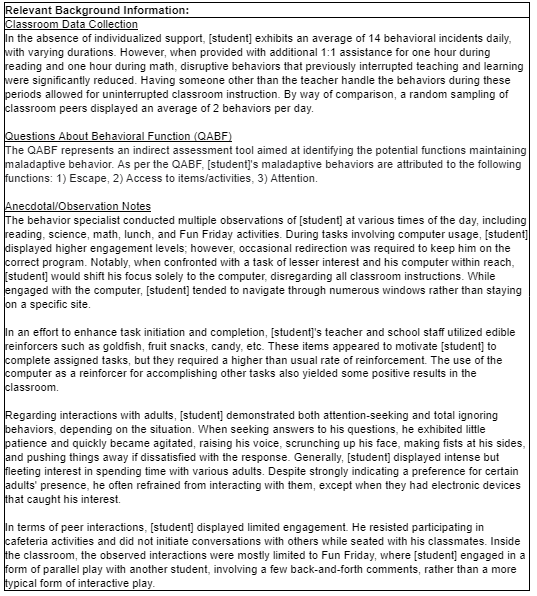
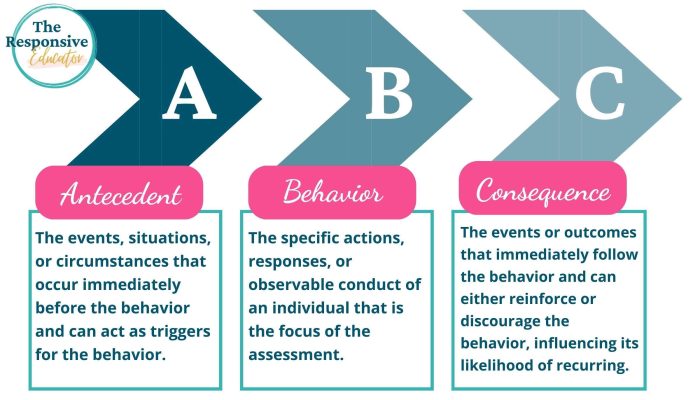
For the next few sections of your functional behaviour assessment, you will need to utilize ABC (antecedent, behavior, consequence) data. This can be time-consuming, but is vital to determining the factors contributing to the inappropriate behavior.
To start, gather information on the antecedents (what comes before the behavior), the observed behaviors, and the consequences (what happens immediately after the behavior) from available records. ABC data can be collected from various sources, including discipline records, incident reports, and direct observations. Analyzing this data helps to pinpoint the most frequent or severe behaviors that require intervention. This data collection should cover a sufficient time period to capture patterns and trends.
If you are looking for a great product to help you analyze your student’s problem behavior and easily create behavior graphs, please check out my product ABC Behavior Charting for FBA. It will save you so much time!
Examine the collected ABC data to identify patterns and recurring behaviors. Look for behaviors that occur most frequently or have the most significant impact on the student’s functioning or the classroom environment. These are the behaviors that should be prioritized as target/problem behaviors.

It is best to focus on 1-3 target/problem behaviors, prioritizing safety concerns first and then disruptive behaviors.
For example, if a student regularly engages in physical aggression, disruption, elopement, task refusal, and sleeping in class, it’s important to tackle the top 2-3 (prioritizing safety concerns and significant disruption) and work to get those under control. Once progress is made, then start working on the behaviors that are less disruptive but are still interfering with the student’s education.
When conducting a functional behaviour assessment, it’s important to clearly define the target/problem behaviors that are of concern. These behaviors must be described in such a way that anyone who reads the definition will be able to confidently identify if the behavior occurred or not. Clear definitions allow all observers to know what they are looking for and document the same behaviors in the same way.
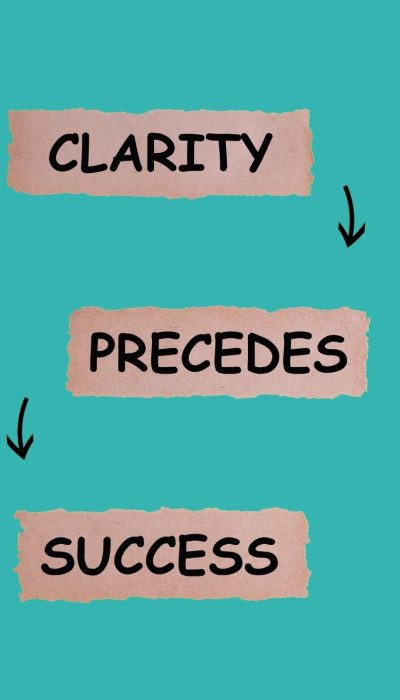
Avoid vague or ambiguous language like “boundary violations” or “instigating.” It’s important to use language that is clear and precise, avoiding definitions that require people to read minds or guess at the intentions of the child.
Instead, define the behavior/s in observable measurable terms. What does the behavior look like? If you watch the child engage in the behavior, what do you see them do? This is also known as a topographical definition.
To enhance clarity, offer both examples and non-examples of the target behaviors. This helps observers understand precisely what is and isn’t considered part of the behavior. For example, if the target behavior is “physical aggression,” provide specific actions that qualify as physical aggression (e.g., hitting, kicking) and non-examples (e.g., high-fiving).
By combining the data-driven insights from ABC analysis with clear definitions of target/problem behaviors, educators and behavior specialists can develop effective behavior intervention plans that specifically address the most pressing issues. These focused strategies contribute to the student’s growth and overall classroom harmony.
The Target/Problem Behaviors section of a Functional Behaviour Assessment might look something like this:
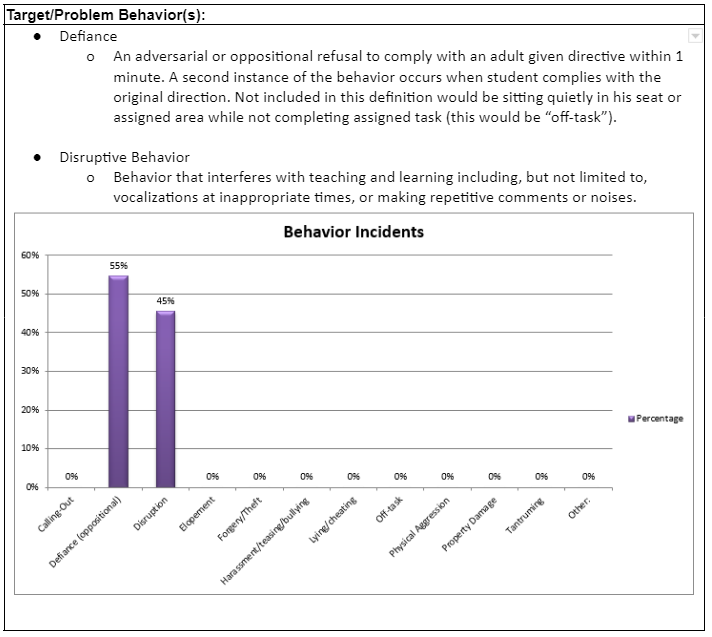
When conducting a functional behaviour assessment (FBA), understanding the context in which a student’s behavior occurs is crucial. This involves considering setting events or environmental factors that may influence the behavior.
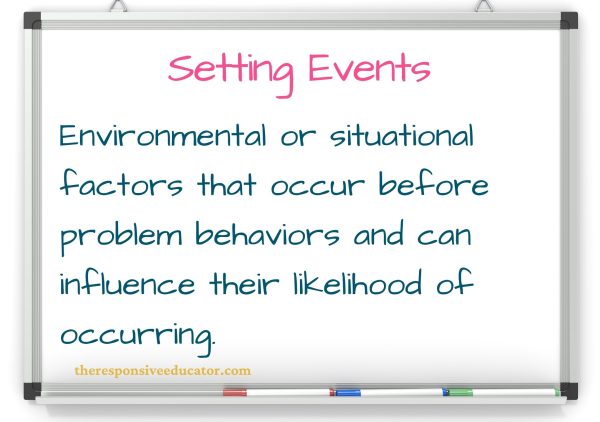
Setting events are situations or conditions that happen before the problem behavior and can create a context in which the behavior is more likely to occur.
To gain deeper insights into the setting events and contextual factors that may contribute to the problem behavior, incorporating ABC (antecedent, behavior, consequence) data is invaluable. ABC data can reveal specific triggers and patterns related to the problem behavior, shedding light on the circumstances that lead to its occurrence.
Begin the contextual analysis by collecting ABC (antecedent, behavior, consequence) data from various sources (as discussed above), including direct observations, teacher interviews, and behavior logs. For example, observe the student during different activities and document what happens right before (antecedent), the observed behavior, and what occurs immediately after (consequence).
Example: During math class (antecedent), the student starts shouting and throwing books on the floor (behavior), and the teacher sends the student out of the classroom (consequence).
Analyze the ABC data to identify the antecedents and consequences associated with the problem behavior. Look for common patterns or events that consistently precede or follow the behavior.
Example: After reviewing several instances of the student’s behavior, you notice that the teacher asking the student to complete a challenging math problem (antecedent) often leads to the disruptive behavior (behavior), and the consequence is the student being removed from the classroom (consequence).

Within the antecedents, look for setting events that might have influenced the behavior. Setting events can be temporary or long-term factors that create a context in which the behavior is more likely to happen.
Example: In addition to the immediate antecedent, you also notice that the student had been absent for several days due to illness (setting event) before returning to school and displaying the disruptive behavior during math class.
Setting events can vary depending on the individual and the specific behavior being analyzed. Some common examples of setting events include:

Incorporate the setting events and contextual factors identified through ABC data analysis into the functional behavior assessment. Consider how these factors may interact with the antecedents and consequences to influence the problem behavior.
Example: Taking the setting event into account, you consider how the student’s recent absence from school due to illness (setting event) might have contributed to their increased frustration and anxiety during math class (antecedent), resulting in the disruptive behavior (behavior), and being removed from the classroom (consequence).

Once educators have identified the relevant settings and situations, they can begin to list and describe the environmental factors that may be contributing to the problem behavior. This may include expectations, nature of activities, length of activities, type or quality of instruction, opportunities/choices, behavior of others, accessibility of reinforcers, and more.
When conducting an FBA, it is essential to consider these setting events along with other factors like antecedents and consequences. Understanding setting events helps to paint a more comprehensive picture of the context in which problem behaviors occur, enabling educators, parents, and behavior specialists to develop effective behavior intervention plans that address the underlying causes of the behaviors.
It is important to list and analyze each behavior separately, even if some of the information is the same for multiple behaviors. This can help identify unique triggers and antecedents for each behavior, ensuring that interventions are tailored to meet the individual needs of the student.
For example, if a student exhibits off-task behaviors during independent reading time, but not during guided reading groups, analyzing the nature of the activity and type of instruction can help identify potential interventions that can address this behavior.
By analyzing the setting events and contextual factors related to the problem behavior, educators can better understand the triggers and antecedents that are contributing to the behavior. This understanding can help them develop effective behavior intervention plans that can address the root causes of the behavior and lead to positive outcomes for the student.
The Setting Events/Contextual Analysis section of a Functional Behaviour Assessment might look something like this:
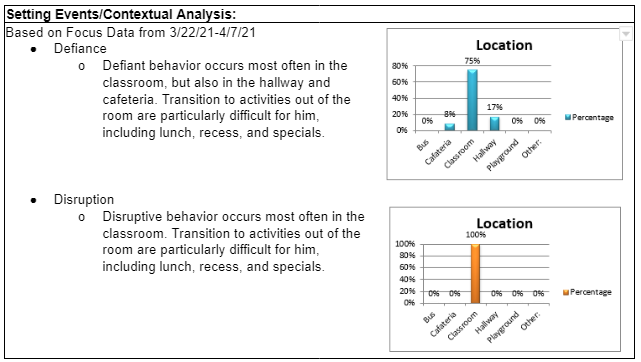
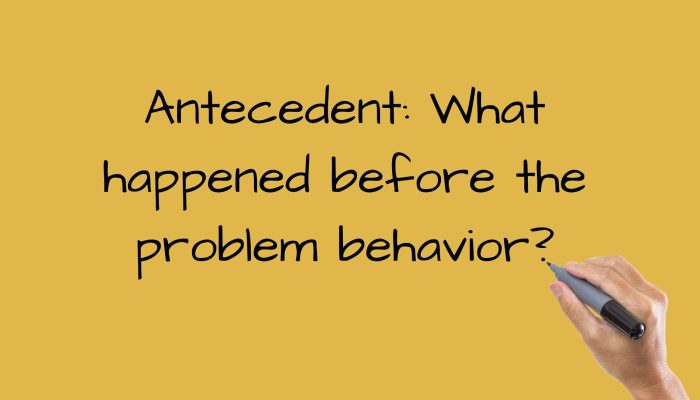
Conducting an antecedent analysis can help identify specific triggers or motivating factors that may be contributing to the behavior. Antecedents refer to the events or conditions that occur immediately before the behavior.
To begin the antecedent analysis, use your ABC (Antecedent, Behavior, Consequence) data to identify specific antecedents for each behavior. This involves examining the events or conditions that occurred immediately before the behavior to determine what may have triggered it.
For example, a student may exhibit defiant behaviors, such as refusing to complete academic work or following teacher directives, when presented with math assignments or asked to read aloud in class. In this case, these specific antecedents would be identified and analyzed as potential triggers for the behavior.
It’s important to break down the antecedent analysis by the specific target behaviors identified in the functional behavior assessment. This allows for a more comprehensive understanding of the unique triggers or motivating factors for each behavior.
For example, if the functional behavior assessment identified two target behaviors for a student – disruptive behaviors during math class and off-task behaviors during independent reading time – the antecedent analysis should be conducted separately for each behavior to identify unique triggers or motivating factors.
When conducting the antecedent analysis, it’s important to use specific examples and percentages to demonstrate the frequency and nature of the antecedents for each behavior. This information can be used to develop interventions that are tailored to meet the specific needs of the student.

For example, if the antecedent analysis revealed that 48% of episodes of defiant behavior were preceded by verbal demands or requests to perform academic work, this information can be used to develop interventions that focus on providing the student with more support and guidance during these activities.
Overall, conducting an antecedent analysis can help educators identify specific triggers or motivating factors that may be contributing to problem behavior, and develop interventions that are tailored to meet the individual needs of the student.
The Motivating Factors/Antecedent Analysis section of a Functional Behaviour Assessment might look something like this:
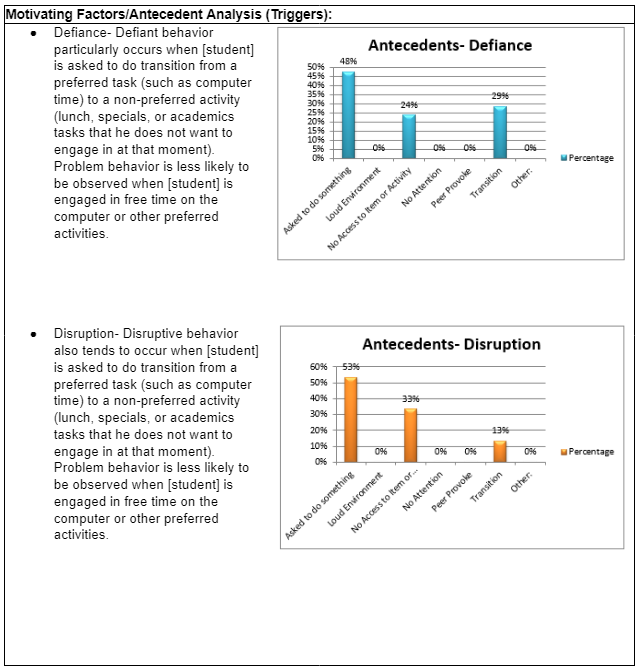
Maintaining Consequences/Consequence Analysis in a functional behaviour assessment involves identifying what happens after the target/problem behavior occurs. It is important to note that consequence in FBA does not only refer to punishment, but it includes any result, either good or bad, that follows the behavior. To conduct a consequence analysis, educators should observe and record what happens immediately after the behavior occurs, including the reactions of peers, teachers, and the student themselves.
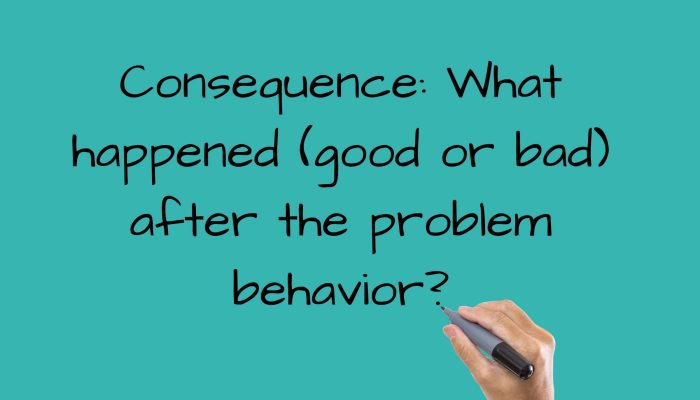
The consequence analysis should include both the consequences delivered by staff and those delivered by the student or the behavior itself. For example, staff consequences may include redirection or sending the student out of the room, while student or behavior consequences may include peers laughing or expressing frustration with the student’s behavior.
It is essential to be as quantitative as possible in the consequence analysis. Quantifying the consequences can help educators identify patterns and trends in the behavior and develop more effective intervention strategies. For example, a consequence analysis may show that 36% of the episodes of disruption resulted in peers laughing, and 42% resulted in school staff redirecting the child.
It is important to connect the consequences to the specific target behaviors identified in the functional behavior assessment. For example, if a student engages in disruptive behavior during group work, the consequence analysis may show that the behavior is maintained by peer attention. In this case, the intervention plan may include strategies to redirect peers’ attention away from the disruptive behavior and towards appropriate behavior.
The Maintaining Consequences/Consequence Analysis section of a Functional Behaviour Assessment might look something like this:
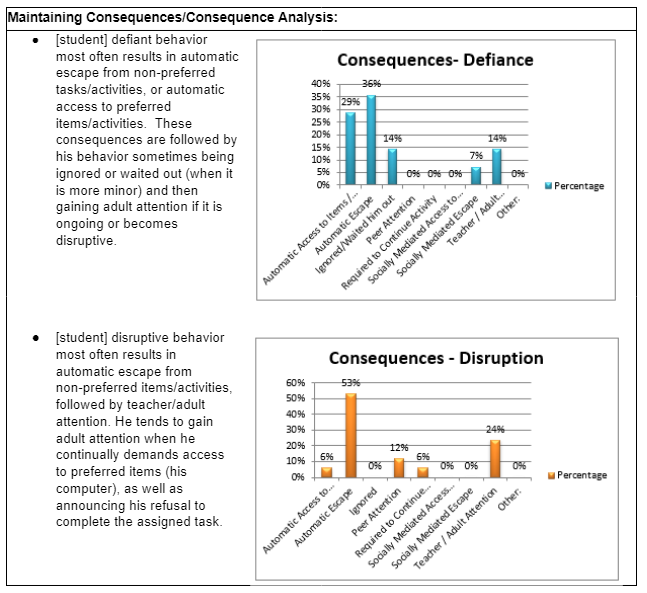
After completing a thorough Functional Behavior Assessment, the educator should know the behavior they want to address, what causes it to happen (antecedents), and what happens afterward (consequences). Using this information, they can come up with a hypothesis about why the behavior is occurring and what purpose it may serve for the student (in other words, why do they keep doing it?).
By identifying the function of a behavior, educators can develop effective intervention plans that address the root cause of the behavior, rather than just treating the symptoms.
Understanding the possible functions of behavior is a critical component of conducting a Functional Behavior Assessment (FBA). By identifying the function of a behavior, educators can develop effective intervention plans that address the root cause of the behavior, rather than just treating the symptoms.
Some students may engage in behaviors to gain attention from adults or peers. For example, a student may call out or interrupt the teacher during class to get attention from their peers. This behavior may be maintained because it produces the desired outcome of attention, even if that attention is negative.

There are people who argue that the term “Connection Seeking” should be used in place of Attention Seeking. While attention seeking and connection seeking share some similarities, they are not exactly the same thing. Let’s break down each term:
While attention-seeking behaviors can be a part of connection-seeking, connection-seeking encompasses a broader range of behaviors and emotions aimed at establishing and maintaining meaningful connections with others. Attention-seeking behaviors may be used as a means to achieve connection, but connection-seeking behaviors are driven by a deeper need for emotional bonds and authentic relationships.

Other students may engage in behaviors to avoid or escape from tasks or situations that they find challenging or unpleasant. For example, a student may act out or refuse to complete a task to avoid doing work that they find difficult or boring. This behavior may be maintained because it allows the student to avoid the unpleasant task, even if that means facing negative consequences like being sent to the principal’s office.
Some students may engage in behaviors to obtain sensory input or stimulation. For example, a student may repeatedly tap a pen on their desk or rock back and forth in their chair to obtain sensory input that is calming or stimulating. This behavior may be maintained because it produces the desired sensory outcome, even if that behavior is disruptive to others.
Finally, some students may engage in behaviors to obtain a desired object or activity. For example, a student may act out or throw a tantrum to get a toy or snack that they want. This behavior may be maintained because it allows the student to obtain the desired object or activity, even if that means facing negative consequences like losing privileges or being reprimanded by adults.
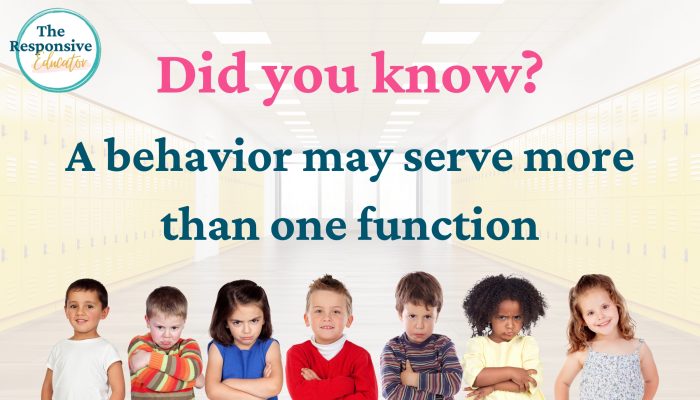
It’s important to note that a behavior may serve more than one function. For example, a student who engages in disruptive behavior during class may be seeking attention from the teacher while also attempting to avoid an unpreferred task. Understanding the possible functions of behavior can help educators develop intervention plans that address all of the functions that a behavior may serve.
A functional hypothesis should be a clear, concise statement that reflects the information gathered during the assessment process. It should provide a clear explanation for why the student is engaging in the behavior, as well as potential consequences that may be maintaining the behavior. It provides a starting point for developing an effective intervention plan to address the behavior.
The Summary/Functional Hypothesis section of a Functional Behaviour Assessment may look something like this:
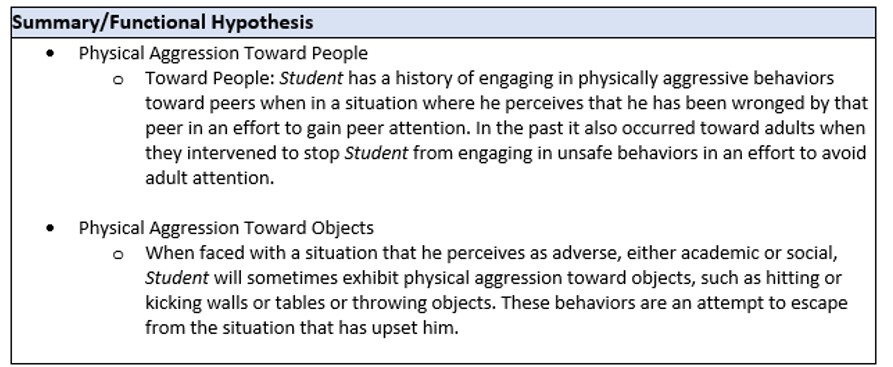
Recommendations are a crucial part of the Functional Behaviour Assessment (FBA) process. Based on the data collected during the assessment, educators can make informed decisions about the next steps for addressing the target behavior. One of the most common recommendations following an FBA is the creation of a Behavior Intervention Plan (BIP).
A BIP is a written plan that outlines the strategies and interventions that will be used to address the target behavior. It should be individualized to the student and based on the specific functions of their behavior identified during the FBA. The BIP should include specific, measurable goals, as well as strategies for both preventing and responding to the target behavior. The goal of a BIP is to replace the problem behavior with more appropriate and socially acceptable alternatives.
In some cases, the information gathered during the FBA may not be sufficient to fully understand the function of the target behavior. Additional assessments may be necessary to gather more information about the student’s behavior, environment, and individual needs.
In some cases, the information gathered during the FBA may not be sufficient to fully understand the function of the target behavior. Additional assessments may be necessary to gather more information about the student’s behavior, environment, and individual needs.
It’s important to note that the recommendations made following the completion of a functional behaviour assessment should be made collaboratively, with input from all members of the student’s educational team. This may include teachers, administrators, school psychologists, and other support staff.
Collaboration helps to ensure that all aspects of the student’s behavior and needs are being addressed and that the strategies used are consistent across all settings and individuals working with the student.

Example of Recommendations section of a Functional Behaviour Assessment:
Completing a functional behaviour assessment can be a time-consuming and complex process, but it is crucial in developing effective behavior interventions for students. By following the steps outlined in this post and utilizing the resources available, educators can gather accurate and comprehensive data to determine the function of target behaviors and create individualized intervention plans.
It is important to remember that behavior is communication, and by understanding the function of a student’s behavior, educators can provide appropriate support and help students succeed academically and socially. By taking the time to complete a thorough functional behavior assessment, and using the data collected, we have a good start toward creating a strong and effective behavior intervention plan that can make a positive impact on our students’ lives.
Completing a thorough Functional Behaviour Assessment can be a time-consuming and complex process, but it’s essential to developing effective behavior intervention plans. Fortunately, I have resources available to help streamline the process and improve your data collection.
Introducing the Manage Classroom Behavior: FBA, BIP, Progress Monitoring (Mega Bundle) – Your Ultimate Time-Saver for Effective Behavior Management!
Included in this comprehensive bundle:
But that’s not all!
Discover the pathway to effective behavior management while saving valuable time on FBAs, BIPs, and progress monitoring graphs. No need to struggle alone – my resources are designed to support you in developing successful behavior intervention plans and fostering student success! Get the Manage Classroom Behavior: FBA, BIP, Progress Monitoring (Mega Bundle) – your all-in-one solution for student behavior monitoring!

Support your students’ individual needs with our exclusive Classroom Concerns Checklist.
Identify key concerns in areas like:
…and more to help drive collaboration and problem-solving.
Sign up now to receive instant access and valuable insights on addressing classroom concerns.
